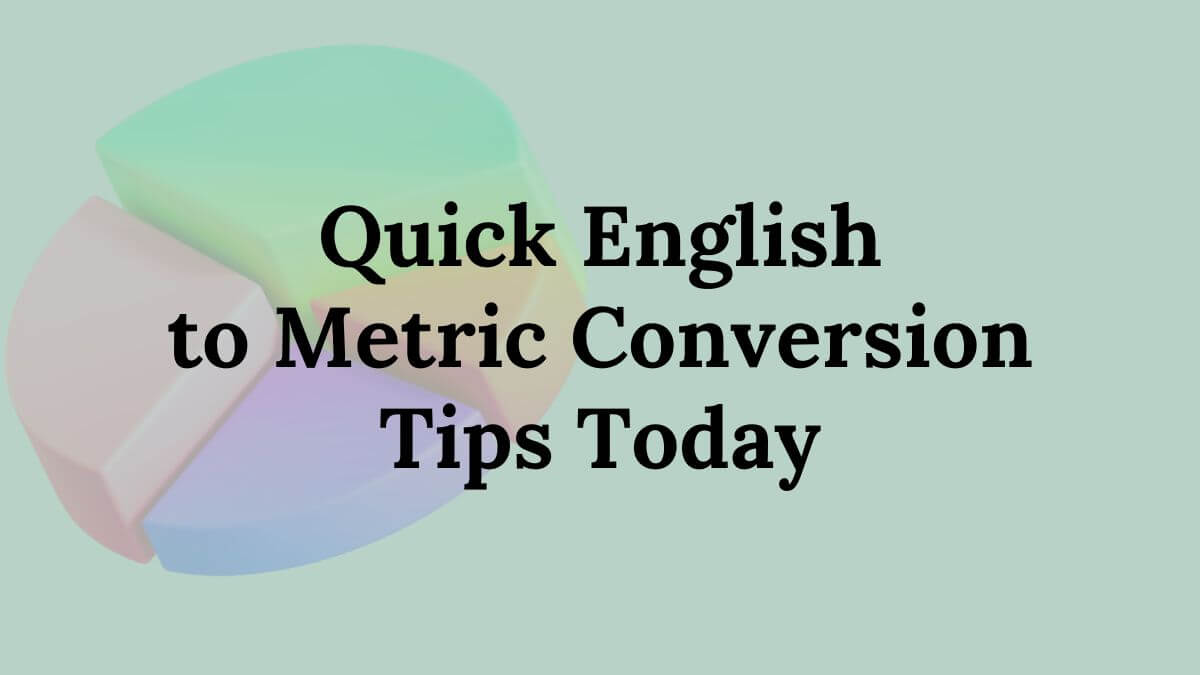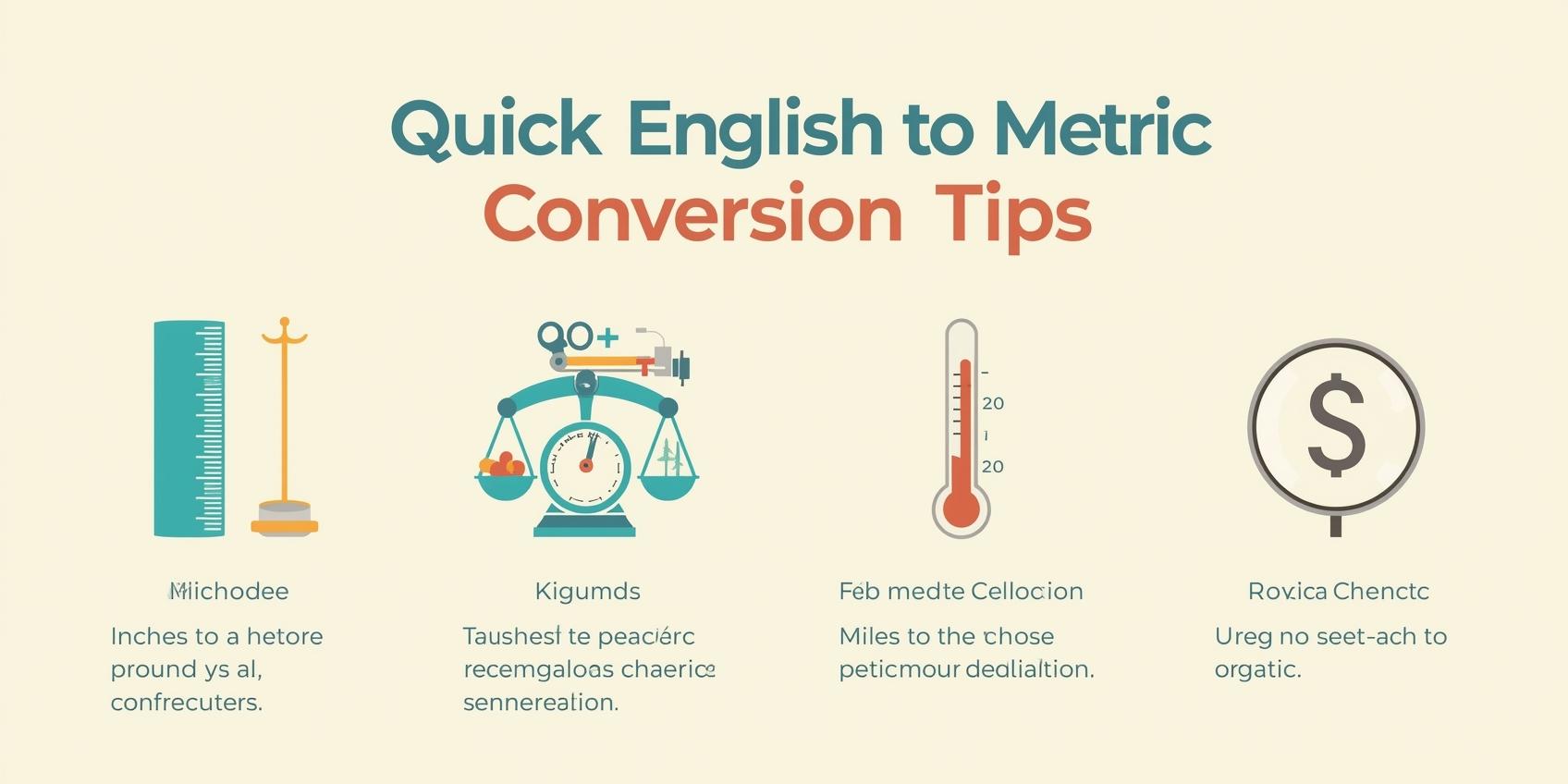Have you ever read a recipe that says 2 pounds of flour, but your local shop sells it in kilograms? Or maybe you saw a road sign in miles, but you are used to kilometers? These situations can be confusing, especially for English learners, and that is where the English to metric conversion Formula becomes very important.
The metric system is used in most countries, while English-speaking nations like the United States still use their own system (imperial or customary). This difference often creates challenges for learners.
In this blog, we will share 5 quick English to metric conversion Formula tips with examples, a metric conversion chart, and everyday unit conversions you can practice. By the end, you will not only know how to convert but also feel confident using measurements in daily life.
Why English to Metric Conversion Formula Matters
Learning English to metric conversion Formula is more than just math. It is about understanding the world around you. Here are some reasons why it matters:
- Global communication: Most of the world uses the metric system, so knowing conversions helps you connect with more people.
- Travel: Road signs, weather reports, and fuel measurements change depending on the country.
- Education: Teachers often need to explain both systems to help students understand better.
- Daily life: Recipes, shopping, and health measurements often use different units.
For example:
- A person in the U.S. might say they are 5’8” tall, while in Europe someone will say they are 173 cm.
- A recipe from America might call for 1 quart of milk, but in Asia, you will find liters.
This shows why learners need a simple metric system guide to bridge the gap between the two systems.
Understanding the Two Systems
Before we jump into the 5 quick tips, it’s important to first understand the basics of English to metric conversion Formula, because knowing how the two systems differ will make learning and practicing much easier.
1. The English System (Imperial/Customary)
This measurement system is mainly used in the United States and a few other regions, which is why learners often need to practice English to metric conversion Formula when traveling or studying internationally. Common units in this system include:
- Length: inches, feet, yards, miles
- Weight: ounces, pounds, tons
- Volume: cups, pints, quarts, gallons
- Temperature: Fahrenheit
2. The Metric System
This is the international standard system of measurement, widely used around the world, and it is built on simple multiples of 10. That is why learners find English to metric conversion formula easier once they understand this pattern. The metric system keeps things consistent and logical. Units in this system include:
- Length: millimeters, centimeters, meters, kilometers
- Weight: grams, kilograms, metric tons
- Volume: milliliters, liters
- Temperature: Celsius
3. Key Difference
The English system is irregular (12 inches = 1 foot, 3 feet = 1 yard, etc.), while the metric system is logical (10 mm = 1 cm, 100 cm = 1 m). This is why learners often prefer a metric conversion chart to make quick comparisons.
5 Quick English to Metric Conversion Formula Tips
Now, let’s explore the 5 practical tips that will help you master English to metric conversion Formula step by step, so you can convert measurements quickly and confidently in real life.
1. Use Simple Multiplication Tricks
Many parts of English to metric conversion Formula can be remembered easily with quick multiplication tricks, allowing you to change units faster without needing a calculator:
- Inches to centimeters: multiply by 2.5
- Example: 10 inches × 2.5 = 25 cm
- Pounds to kilograms: divide by 2.2
- Example: 110 pounds ÷ 2.2 ≈ 50 kg
- Miles to kilometers: multiply by 1.6
- Example: 5 miles × 1.6 = 8 km
- Fahrenheit to Celsius: subtract 32, then multiply by 5/9
- Example: (98°F – 32) × 5/9 = 36.6°C
These quick calculations make conversions easy without a calculator. Teachers can also encourage students to practice these in class.
2. Learn with a Metric Conversion Chart
A metric conversion chart is one of the most useful tools for anyone learning English to metric conversion Formula. It provides clear, side-by-side comparisons of units in both the English and metric systems, making it easier to understand, memorize, and apply conversions in everyday situations.
Here’s a simple example:
| English Unit | Metric Unit | Quick Conversion |
| 1 inch | 2.54 cm | × 2.5 |
| 1 foot | 30.48 cm | ≈ 30 cm |
| 1 yard | 0.91 m | ≈ 1 m |
| 1 mile | 1.61 km | × 1.6 |
| 1 pound | 0.45 kg | ÷ 2.2 |
| 1 gallon | 3.78 liters | ≈ 3.8 L |
By hanging a chart in your study room or classroom, you can remind yourself of common conversions every day.
3. Practice Everyday Unit Conversions
One of the most effective ways to master English to metric conversion Formula is by using it in your daily life. Consistent practice helps make conversions second nature. Here are some practical ways you can apply what you’ve learned every day:
- Cooking: If a recipe calls for 2 pounds of potatoes, convert it to kilograms (≈ 0.9 kg).
- Shopping: When you buy a drink labeled 1 liter, think about how many cups that would be (≈ 4 cups).
- Traveling: If a sign says the city is 50 miles away, convert it to kilometers (≈ 80 km).
By making conversions part of your everyday unit conversions, you will naturally remember them. Teachers can create role-play activities where students shop, cook, or travel using both systems.
4. Use Online Tools and Apps
Technology can make mastering English to metric conversion Formula much easier. There are numerous apps, websites, and online tools designed for quick unit conversion. Some even allow you to enter measurements using voice commands, making it fast and convenient to convert units anytime, anywhere.
Popular tools include:
- Google search (10 pounds in kilograms)
- Mobile calculator apps with conversion options
- Educational apps that combine Learn English measurements with practice exercises
But remember: while apps are helpful, try to practice manually too. This way, you won’t depend only on technology.
5. Remember the Metric System is Easier
One of the most important things to remember when learning English to metric conversion Formula is that the metric system, when explained clearly, is actually much simpler and more logical than the English system. Its units are based on multiples of 10, which makes converting lengths, weights, and volumes easier and more consistent in everyday use. Why?
- It is based on powers of 10.
- Units connect smoothly (1000 g = 1 kg, 100 cm = 1 m).
- You only need to learn a few prefixes: mile (1/1000), centi- (1/100), kilo- (1000).
Example:
- 1 kilometer = 1000 meters
- 1 centimeter = 0.01 meter
- 1 milliliter = 0.001 liter
Once learners understand this pattern, converting becomes natural. That’s why teachers often encourage students to think in metric first, then compare with English units.
Common Mistakes in English to Metric Conversion Formula
Even with regular practice, learners often make mistakes when dealing with English to metric conversion Formula. Here are some of the most common errors you should watch out for and avoid:
- Mixing volume and weight: For example, confusing liters with kilograms.
- Rounding too much: Saying 1 pound = 0.5 kg (it’s actually 0.45 kg).
- Forgetting temperature formulas: Celsius and Fahrenheit do not convert with simple multiplication.
- Skipping practice: Only reading charts but not using them in real life.
To avoid these, always double-check your conversions and practice regularly.
How Teachers Can Help Students
Teachers play an important role in making English to metric conversion Formula easy for learners. Here are some classroom ideas:
- Visual aids: Hang a big metric conversion chart on the wall.
- Games: Create quizzes where students race to convert units.
- Role play: Ask students to act out shopping or traveling situations.
- Practice worksheets: Give problems that mix both systems.
These methods make learning fun and practical
Practical Activities to Master English to Metric Conversion Formula
Learning English to metric conversion Formula becomes much more effective when students practice actively instead of just memorizing charts or formulas. Practical activities help learners connect numbers with real-life situations, making the process easier and more enjoyable. Here are some engaging activities you can try both at home and in the classroom.
1. Cooking Conversion Challenge
Cooking provides a practical and enjoyable way to practice English to metric conversion Formula in real life. Teachers or learners can take a recipe written in English units – like pounds, ounces, or cups—and convert the ingredients into metric measurements such as kilograms, grams, or liters. This hands-on approach not only reinforces conversion skills but also helps learners see how everyday unit conversions are used in real situations.
For example:
- Recipe says 2 pounds of chicken → Convert to kilograms (≈ 0.9 kg).
- Recipe says 1 quart of milk → Convert to liters (≈ 0.95 L).
- Recipe says 12 ounces of sugar → Convert to grams (≈ 340 g).
This activity not only teaches conversions but also improves vocabulary related to food and cooking.
2. Travel Distance Game
A fun way to practice English to metric conversion Formula is through a travel activity. Ask learners to plan a trip between two cities: one student provides distances in miles, and the other converts them into kilometers. For example, if a route is 120 miles, the learner would convert it to approximately 193 kilometers. This activity not only reinforces unit conversion skills but also shows how everyday unit conversions are useful in real-life situations like travel planning.
Example:
- Chicago to New York: 790 miles → ≈ 1270 km
- London to Manchester: 210 miles → ≈ 338 km
This makes everyday unit conversions more interesting, especially for learners who love geography and travel.
3. Measurement Hunt in the Classroom
Teachers can place objects around the room with measurement labels in English units. Students must measure or convert them into metric.
For instance:
- A book labeled 10 inches long → Convert to centimeters (≈ 25 cm).
- A box labeled 5 pounds → Convert to kilograms (≈ 2.3 kg).
This hands-on activity makes learning fun and memorable.
4. Health & Fitness Practice
Students can also apply conversions to fitness.
Examples:
- Weight: “I weigh 150 pounds.” → Convert to kilograms (≈ 68 kg).
- Height: “I am 6 feet tall.” → Convert to centimeters (≈ 183 cm).
- Temperature: “The body temperature is 100°F.” → Convert to Celsius (≈ 37.7°C).
These examples connect to real life and help learners use Learn English measurements naturally.
5. Quiz and Pair Work
Teachers can design quick quizzes or interactive pair activities to help students practice English to metric conversion Formula. For example, one student can ask, How many kilometers is 5 miles? while the other provides the correct answer (≈ 8 km). This type of pair work not only reinforces conversation skills but also boosts confidence, encourages communication, and makes learning both engaging and practical for real-life applications.
Advanced Tips for Better Conversion Skills
Once learners feel confident with the basics of English to metric conversion Formula, they can gradually move on to more advanced tips and strategies that make conversions faster, more accurate, and easier to apply in real-life situations.
1. Memorize Key Conversion Numbers
It is not necessary to remember every detail, but knowing a few key numbers helps a lot:
- 1 inch ≈ 2.5 cm
- 1 foot ≈ 30 cm
- 1 yard ≈ 1 meter
- 1 mile ≈ 1.6 km
- 1 pound ≈ 0.45 kg
- 1 gallon ≈ 3.8 liters
These are enough for most daily situations.
2. Use Real-World Contexts
When you shop for fruits, vegetables, or drinks, always check the packaging. Compare the labels in liters vs. quarts or kilograms vs. pounds.
For example:
- Orange juice bottle: 2 liters → Think about how many quarts that would be (≈ 2.1 quarts).
- Bag of rice: 5 kg → Compare with pounds (≈ 11 pounds).
This habit will strengthen your conversion skills naturally.
3. Create Your Own Conversion Journal
Keep a small notebook where you write:
- Common conversions you use daily.
- Mistakes you made and corrected.
- New examples from real life.
This simple metric system guide will grow into your personal reference book.
4. Practice Mental Math
Rather than relying solely on a calculator, practice doing English to metric conversion Formula in your head. Mental calculations help you become faster and more confident when converting units in real-life situations. For instance, if 1 mile is approximately 1.6 kilometers, then 10 miles would be about 16 kilometers. Similarly, if 1 kilogram is roughly 2.2 pounds, 5 kilograms would be about 11 pounds:
- If 1 mile ≈ 1.6 km, then 10 miles ≈ = 16 km.
- If 1 kg ≈ is 2.2 pounds, then 5 kg ≈ is 11 pounds.
This will improve your math skills and make you faster in real-life situations.
5. Compare with Friends or Classmates
Turn conversions into a game. Each person converts a measurement, and the others check for accuracy. A friendly competition motivates learners to be precise and confident.
English to Metric Conversion Formula for Teachers
Teachers play a vital role in helping students understand and master English to metric conversion formula. By using the right teaching strategies, they can turn what often feels like a complex topic into a simple and engaging learning experience. Here are a few effective strategies teachers can apply in the classroom:
1. Use Visual Comparisons
Bring real objects to class, such as a 1-liter water bottle, a 1-kilogram bag of rice, or a 12-inch ruler. Students can see and feel the difference between English and metric measurements.
2. Introduce Conversion through Stories
Tell simple stories like:
Emma is traveling from the U.S. to Europe. She is 5’6” tall. How tall is she in centimeters?
These stories make practice more engaging than just numbers.
3. Connect to Daily English Conversation
Encourage students to use conversions in speaking practice:
- I walked 3 miles today; that’s about 5 kilometers.
- This bottle has 2 liters of water, almost half a gallon.
This way, conversions become part of Daily English conversation.
4. Provide Conversion Worksheets
Design worksheets with mixed problems. For example:
- Convert 12 inches to centimeters.
- Convert 2 gallons to liters.
- Convert 30°C to Fahrenheit.
This builds accuracy and confidence step by step.
5. Encourage Independent Learning
Ask students to explore conversion apps, create their own metric conversion chart, or teach their family members. Teaching others is one of the best ways to learn deeply.
The Future of English to Metric Conversion Formula
Interestingly, even though the metric system is more logical and widely used, the English system is still common in the U.S. Because of this, learners need to understand both.
In the future, global communication, international trade, and travel may increase the use of the metric system even more. This means learners who practice conversions now will have an advantage.
Conclusion
Learning English to metric conversion Formula does not need to be difficult. With simple multiplication tricks, a handy metric conversion chart, and regular practice through everyday unit conversions, anyone can master it. Remember that the metric system explained is actually much easier once you understand the pattern of 10.
Teachers can make lessons fun through activities, while students can apply conversions in cooking, travel, shopping, and health. Most importantly, practice daily, use examples, and keep a positive attitude.
In short, mastering conversions is not only a math skill but also a language skill. It helps you understand English better, communicate globally, and feel confident in real situations. So, start today – practice, convert, and grow.
By following these 5 quick tips, you will soon see how English to metric conversion Formula can become second nature. Keep learning, keep practicing, and you will succeed.


